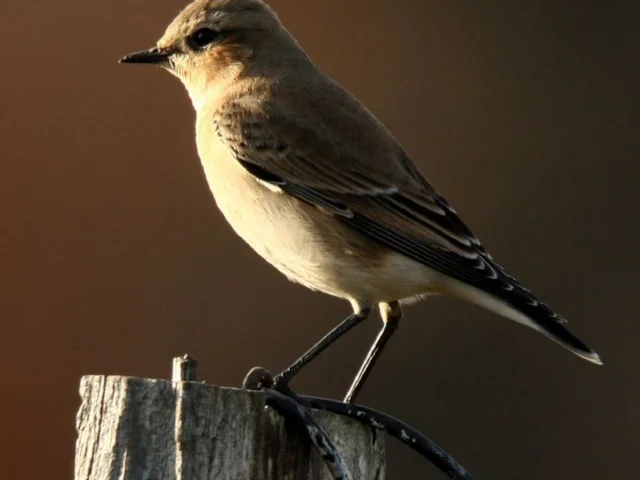Wheatears travel even further than was thought
2d907bcd-88df-434f-b686-5af460780dc2

Radio-tagged Northern Wheatears can travel to sub-Saharan Africa for winter – even if they hatched in Alaska – a new study has revealed.
Northern Wheatear has an almost trans-northern hemisphere range, breeding from the eastern Canadian Arctic through Greenland and Eurasia and into Alaska, USA. It is only missing from the central areas of northern North America, but occurs as a vagrant.
It has long been known that individuals of the Greenland subspecies Oenanthe oenanthe leucorhoa travel as far as South Africa, but now it has been shown that Alaskan birds also continue to make a journey to the Old World, travelling 9,000 miles across central Eurasia to Central and East Africa. Eastern Canadian birds cross the Atlantic, travelling 2,200 miles across open ocean to use Britain and Ireland as staging posts, like their Greenland cousins.
Geolocators were attached to 30 individuals of the 25 g insect-eating passerines at Eagle Summit, Alaska, and 16 more on Baffin Island, Canada, in June 2009 and July 2010. While only five of the Alaskan birds returned, the data collected revealed them as having spent the winter in Sudan, Uganda or Kenya. They had travelled across northern Russia and Kazakhstan the previous autumn, before crossing the Arabian desert. The total journey of around 9,000 miles took an average of 91 days. The return journeys were similar, but the breeding imperative helped them knock about one month from the travelling time.
Just two of the Baffin Island birds made it back, but at least one of these took just four days to travel from its birthplace to Britain, before covering another 2,500 miles to Mauretania. Again, the same route was used to return, but this was quicker in the autumn, at 26 days, than spring, at 55 days.
Stable isotope analysis of the birds confirmed these results, when feathers newly grown on their wintering grounds were measured for tell-tale hydrogen isotope levels, though one Alaskan bird ended up in West Africa and one Canadian in East Africa.
The authors speculate that these seemingly illogical and dangerous migration strategies could have evolved in an Ice Age expansion of the species’ breeding range. Enough of the birds survive to maintain the breeding populations and the genetic programming of the migration route, despite the heavy death toll that the journeys entail.
Proportionate to size, this is one of the very longest annual round-trips of any bird species on earth, and is even more astounding considering the birds’ sizes and the fact that juveniles perform these feats on their own without previous experience.
Reference
Vairlein, F, Norris, D R, Nagel, R, Bulte, M, Voigt, C C, Fox, J W, Hussell, D J T, and Schmaljohann, H. 2014. Cross-hemisphere migration of a 25 g songbird. Biology Letters doi: 10.1098/rsbl.2011.1223.
Northern Wheatear has an almost trans-northern hemisphere range, breeding from the eastern Canadian Arctic through Greenland and Eurasia and into Alaska, USA. It is only missing from the central areas of northern North America, but occurs as a vagrant.
It has long been known that individuals of the Greenland subspecies Oenanthe oenanthe leucorhoa travel as far as South Africa, but now it has been shown that Alaskan birds also continue to make a journey to the Old World, travelling 9,000 miles across central Eurasia to Central and East Africa. Eastern Canadian birds cross the Atlantic, travelling 2,200 miles across open ocean to use Britain and Ireland as staging posts, like their Greenland cousins.
Geolocators were attached to 30 individuals of the 25 g insect-eating passerines at Eagle Summit, Alaska, and 16 more on Baffin Island, Canada, in June 2009 and July 2010. While only five of the Alaskan birds returned, the data collected revealed them as having spent the winter in Sudan, Uganda or Kenya. They had travelled across northern Russia and Kazakhstan the previous autumn, before crossing the Arabian desert. The total journey of around 9,000 miles took an average of 91 days. The return journeys were similar, but the breeding imperative helped them knock about one month from the travelling time.
Just two of the Baffin Island birds made it back, but at least one of these took just four days to travel from its birthplace to Britain, before covering another 2,500 miles to Mauretania. Again, the same route was used to return, but this was quicker in the autumn, at 26 days, than spring, at 55 days.
Stable isotope analysis of the birds confirmed these results, when feathers newly grown on their wintering grounds were measured for tell-tale hydrogen isotope levels, though one Alaskan bird ended up in West Africa and one Canadian in East Africa.
The authors speculate that these seemingly illogical and dangerous migration strategies could have evolved in an Ice Age expansion of the species’ breeding range. Enough of the birds survive to maintain the breeding populations and the genetic programming of the migration route, despite the heavy death toll that the journeys entail.
Proportionate to size, this is one of the very longest annual round-trips of any bird species on earth, and is even more astounding considering the birds’ sizes and the fact that juveniles perform these feats on their own without previous experience.
Reference
Vairlein, F, Norris, D R, Nagel, R, Bulte, M, Voigt, C C, Fox, J W, Hussell, D J T, and Schmaljohann, H. 2014. Cross-hemisphere migration of a 25 g songbird. Biology Letters doi: 10.1098/rsbl.2011.1223.

